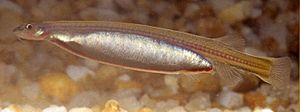Candiru facts for kids
Quick facts for kids Candiru |
|
|---|---|
 |
|
| A candiru after a full meal of blood | |
| Scientific classification |
The Candiru (also known as canero or toothpick fish) is a small, eel-shaped freshwater catfish. It belongs to the Trichomycteridae family. You can find these fish in the Amazon River in South America. For people living there, the Candiru is one of the most feared fish in the water, even more than the piranha.
Candiru are translucent, meaning they are almost clear. This makes them very hard to spot in the water. Some types of Candiru can grow up to 6 inches (about 15 cm) long. The area with the most Candiru is where the Amazon River meets the Rio Negro. This spot is near Brazil's inland city of Manaus.
How Candiru Find Food
Candiru are parasites. This means they get their food by living on or in another animal. They are very good at finding tiny water currents made by breathing fish. This skill allows them to swim into the gill openings of other aquatic animals. Once inside, they feed on the prey's blood.
Not all Candiru eat blood. Some types, like those in the Stegophilinae group, might eat scales, mucus, or even dead animals (carrion).
Hunting for a Meal
To hunt, the Candiru waits at the bottom of the river. It "sniffs" the water for special chemicals. These chemicals, like urea and ammonia, come from the gills of other fish. When a Candiru finds a fish nearby, it quickly rushes into the fish's gill cavity. It then uses its spines to attach itself.
The Candiru then makes a small hole to reach a major blood vessel. It quickly fills itself with blood, usually in just a few minutes. This feeding often causes the victim fish to die. After eating, the Candiru lets go and sinks back to the riverbed. There, it will digest its meal and wait for its next one.
Candiru and People
Smaller types of Candiru have been thought to swim into a person's urethra. Stories about this go back to the 1800s. However, the first written case of a Candiru being removed from a person was not until 1997. Even that incident is not fully believed by everyone.
It was once thought that Candiru were attracted to urine. But this idea appears to be incorrect. Scientists now believe these fish actually hunt by sight. They do not seem to like urine at all.

